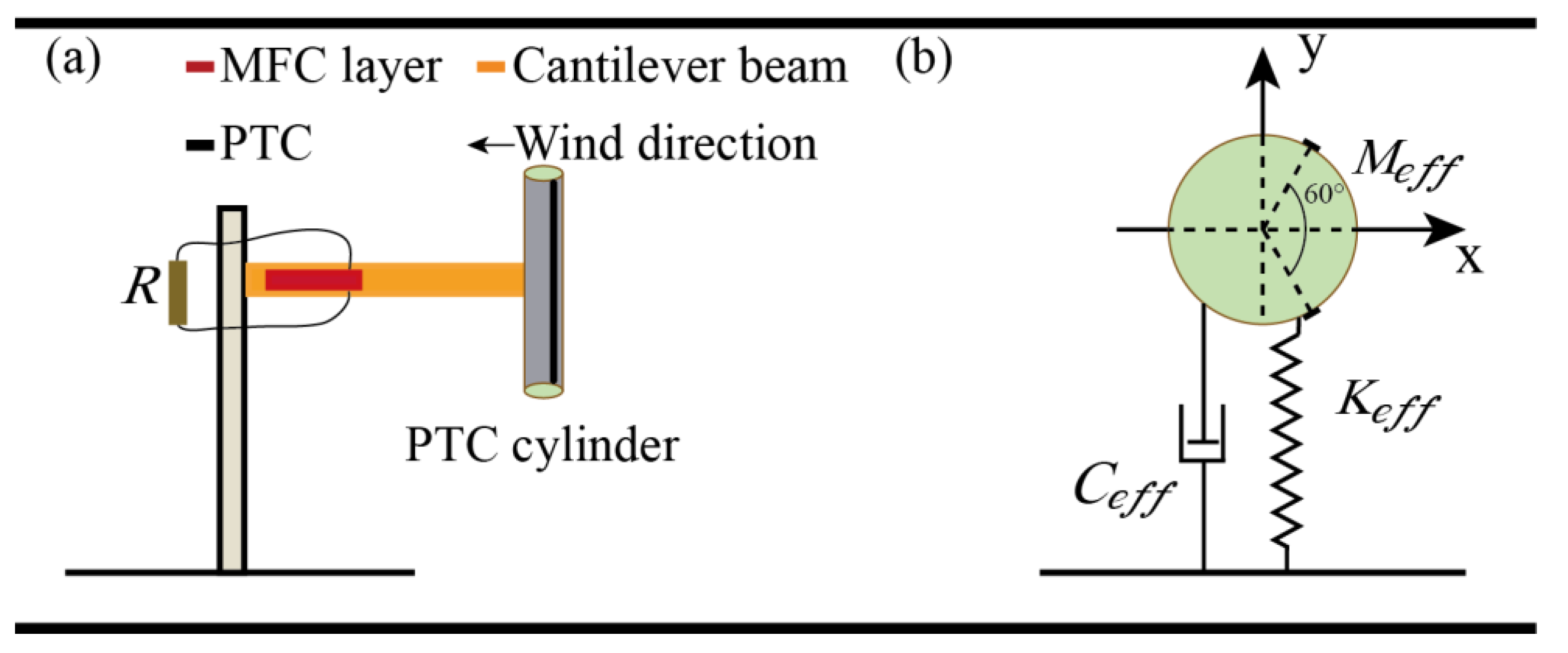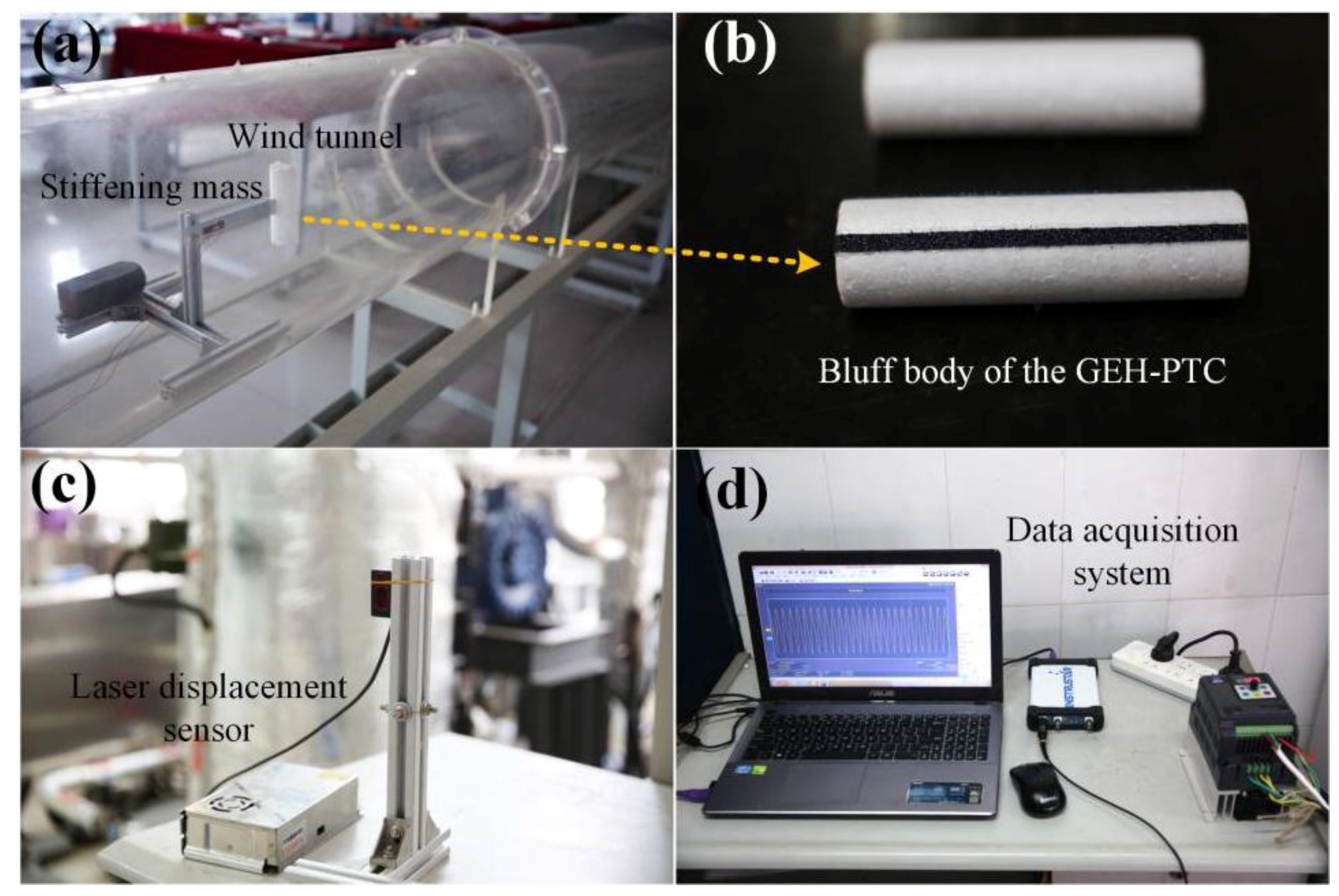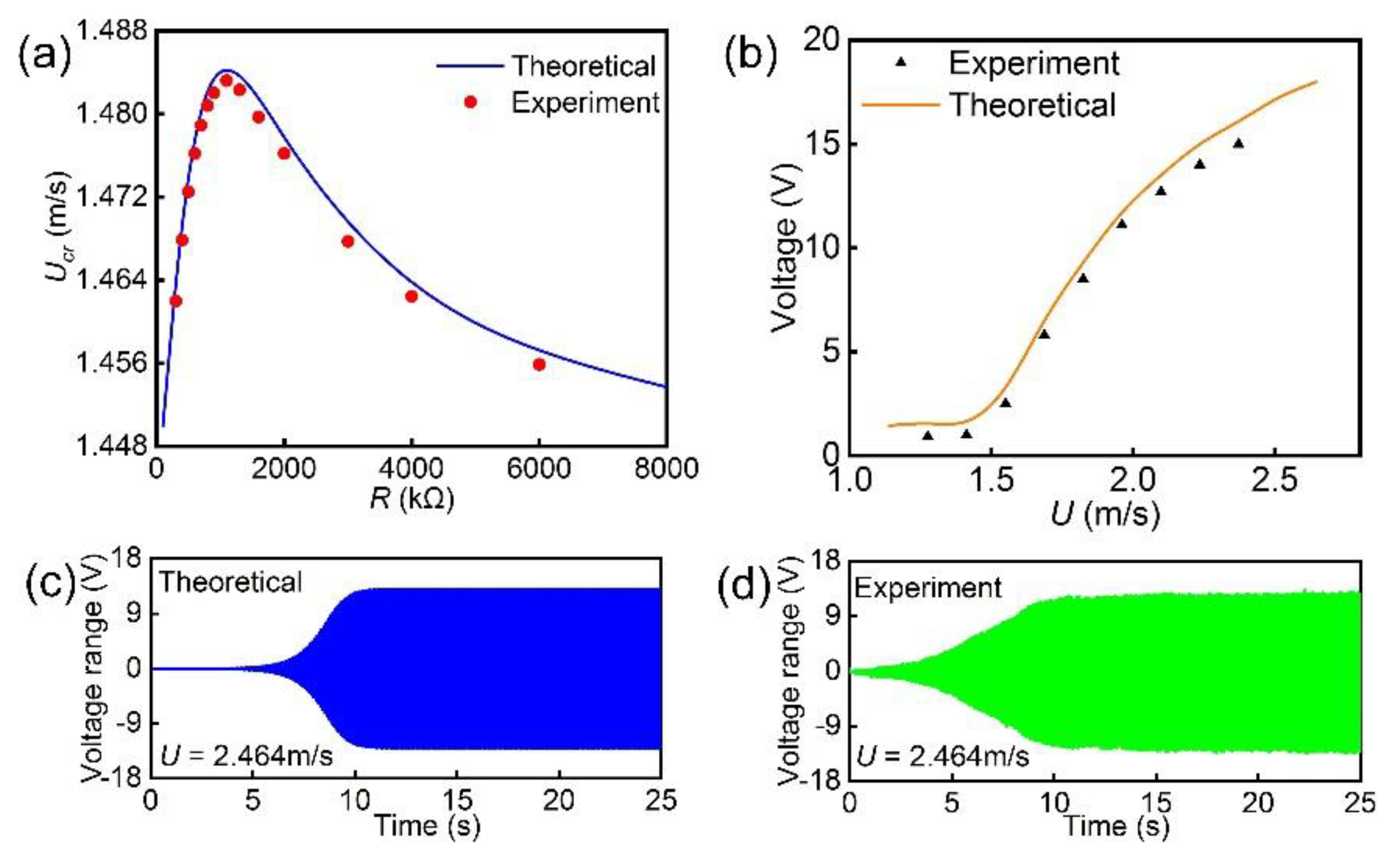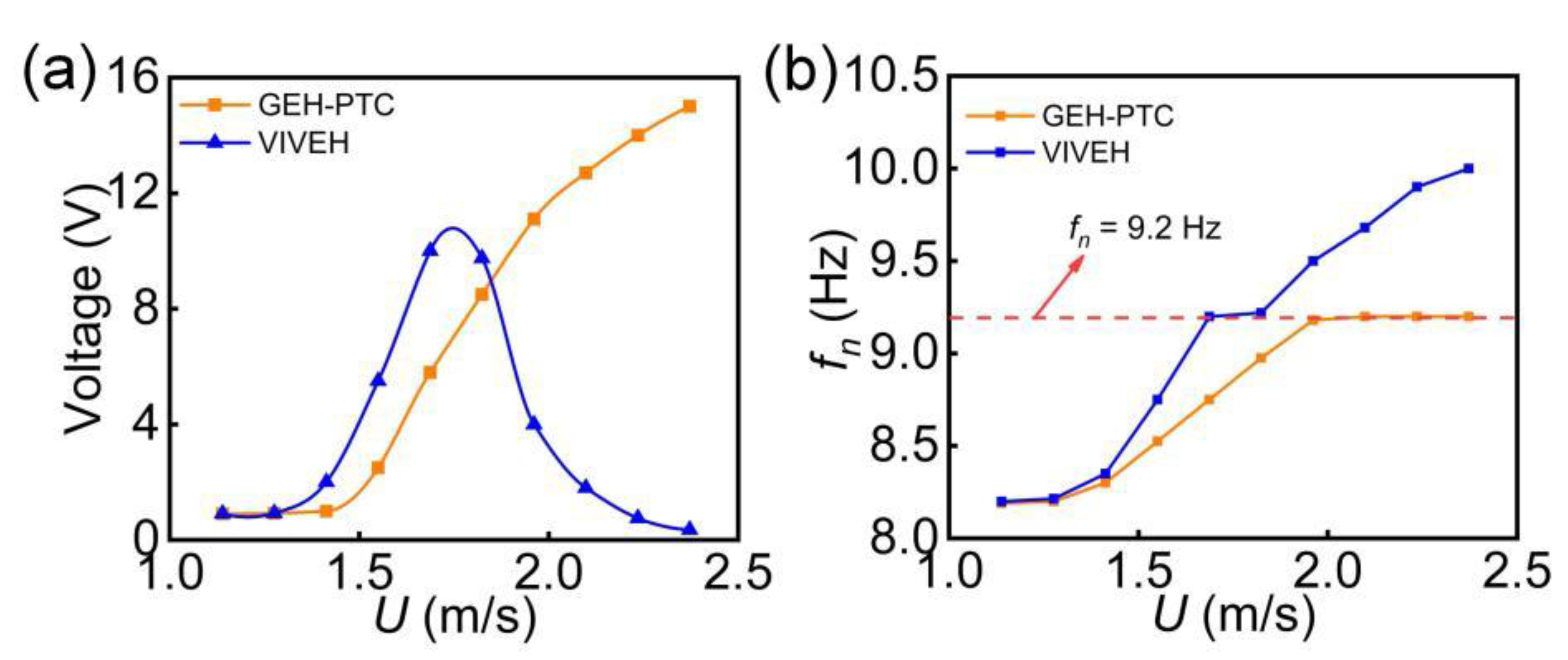Enhancing Wind Energy Harvesting Using Passive Turbulence Control Devices
Abstract
:1. Introduction
2. Physical Mathematical Model
2.1. Physical and Mathematical Model
2.2. Solution and Verification of the Model
3. Performance of the GEH-PTC
4. Effect of the Coupling Strength
4.1. Effect of Coupling Strength
4.2. Effect of the Coupling Strength on Displacement
5. Conclusions
Author Contributions
Acknowledgments
Conflicts of Interest
References
- Beeby, S.P.; Tudor, M.J.; White, N.M. Energy harvesting vibration sources for microsystems applications. Meas. Sci. Technol. 2006, 17, R175–R195. [Google Scholar] [CrossRef]
- Erturk, A.; Hoffmann, J.; Inman, D.J. A piezomagnetoelastic structure for broadband vibration energy harvesting. Appl. Phys. Lett. 2009, 94, 254102. [Google Scholar] [CrossRef] [Green Version]
- Litak, G.; Friswell, M.I.; Adhikari, S. Magnetopiezoelastic energy harvesting driven by random excitations. Appl. Phys. Lett. 2010, 96, 214103. [Google Scholar] [CrossRef]
- Zhou, S.X.; Cao, J.Y.; Erturk, A.; Lin, J. Enhanced broadband piezoelectric energy harvesting using rotatable magnets. Appl. Phys. Lett. 2013, 102, 173901. [Google Scholar] [CrossRef]
- Wei, C.F.; Jing, X.J. A comprehensive review on vibration energy harvesting: Modelling and realization. Renew. Sustain. Energy Rev. 2017, 74, 1–18. [Google Scholar] [CrossRef]
- Ferrari, M.; Ferrari, V.; Guizzetti, M.; Andò, B.; Baglio, S.; Trigona, C. Improved energy harvesting from wideband vibrations by nonlinear piezoelectric converters. Sens. Actuators A Phys. 2010, 162, 425–431. [Google Scholar] [CrossRef]
- Chen, L.Q.; Jiang, W.A. Internal resonance energy harvesting. J. Appl. Mech. 2015, 82, 031004. [Google Scholar] [CrossRef]
- Chen, L.Q.; Jiang, W.A.; Panyam, M.; Daqaq, M.F. A broadband internally resonant vibratory energy harvester. J. Vib. Acoust. 2016, 138, 061007. [Google Scholar] [CrossRef]
- Zhou, S.X.; Zuo, L. Nonlinear dynamic analysis of asymmetric tristable energy harvesters for enhanced energy harvesting. Commun. Nonlinear Sci. Numer. Simul. 2018, 61, 271–284. [Google Scholar] [CrossRef]
- Huang, D.M.; Zhou, S.X.; Litak, G. Theoretical analysis of multi-stable energy harvesters with high-order stiffness terms. Commun. Nonlinear Sci. Numer. Simul. 2019, 69, 270–286. [Google Scholar] [CrossRef]
- Ding, L.; Bernitsas, M.M.; Kim, E.S. 2-D URANS vs. experiments of flow induced motions of two circular cylinders in tandem with passive turbulence control for 30,000 <Re <105,000. Ocean Eng. 2013, 72, 429–440. [Google Scholar]
- Wang, J.L.; Zhao, G.F.; Zhang, M.; Zhang, Z.E. Efficient study of a coarse structure number on the bluff body during the harvesting of wind energy. Energy Sources Part A Recovery Utilization Environ. Eff. 2018, 40, 1788–1797. [Google Scholar] [CrossRef]
- Wang, J.L.; Zhou, S.X.; Zhang, Z.E.; Yurchenko, D. High-performance piezoelectric wind energy harvester with Y-shaped attachments. Energy Convers. Manag. 2019, 181, 645–652. [Google Scholar] [CrossRef]
- Wu, N.; Wang, Q.; Xie, X.D. Ocean wave energy harvesting with a piezoelectric coupled buoy structure. Appl. Ocean Res. 2015, 50, 110–118. [Google Scholar] [CrossRef]
- Chen, N.; Wei, T.C.; Jung, H.J.; Lee, S. Quick self-start and minimum power-loss management circuit for impact-type micro wind piezoelectric energy harvesters. Sens. Actuators A Phys. 2017, 263, 23–29. [Google Scholar] [CrossRef]
- Abdelkefi, A. Aeroelastic energy harvesting: A review. Int. J. Eng. Sci. 2016, 100, 112–135. [Google Scholar] [CrossRef]
- Güney, M.S.; Kaygusuz, K. Hydrokinetic energy conversion systems: A technology status review. Renew. Sustain. Energy Rev. 2010, 14, 2996–3004. [Google Scholar] [CrossRef]
- Lee, J.H.; Xiros, N.; Bernitsas, M.M. Virtual damper–spring system for VIV experiments and hydrokinetic energy conversion. Ocean Eng. 2011, 38, 732–747. [Google Scholar] [CrossRef]
- Cada, G.; Ahlgrimm, J.; Bahleda, M.; Bigford, T.; Stavrakas, S.; Hall, D.; Moursund, R.; Sale, M. Potential impacts of hydrokinetic and wave energy conversion technologies on aquatic environments. Fisheries 2007, 32, 174–181. [Google Scholar] [CrossRef]
- Neary, V.S.; Gunawan, B.; Sale, D.C. Turbulent inflow characteristics for hydrokinetic energy conversion in rivers. Renew. Sustain. Energy Rev. 2013, 26, 437–445. [Google Scholar] [CrossRef]
- Chen, Z.S.; He, J.; Liu, J.H.; Xiong, Y. Switching delay in self-powered nonlinear piezoelectric vibration energy harvesting circuit: Mechanisms, effects, and solutions. IEEE Trans. Power Electron. 2019, 34, 2427–2440. [Google Scholar] [CrossRef]
- Zhang, M.; Wang, J.L. Experimental study on piezoelectric energy harvesting from vortex-induced vibrations and wake-induced vibrations. J. Sens. 2016, 2016, 2673292. [Google Scholar] [CrossRef]
- Wu, Y.P.; Qiu, J.H.; Zhou, S.X.; Ji, H.; Chen, Y.; Li, S. A piezoelectric spring pendulum oscillator used for multi-directional and ultra-low frequency vibration energy harvesting. Appl. Energy 2018, 231, 600–614. [Google Scholar] [CrossRef]
- Wang, J.L.; Geng, L.F.; Zhang, M.; Zhan, G.; Zhang, M.; Zhang, Z.; Li, Y. Broadening Band of Wind Speed for Aeroelastic Energy Scavenging of a Cylinder through Buffeting in the Wakes of a Squared Prism. Shock Vib. 2018, 2018, 2039561. [Google Scholar] [CrossRef]
- Kitio Kwuimy, C.A.; Litak, G.; Borowiec, M.; Nataraj, C. Performance of a piezoelectric energy harvester driven by air flow. Appl. Phys. Lett. 2012, 100, 024103. [Google Scholar] [CrossRef]
- Liu, H.C.; Zhong, J.W.; Lee, C.K.; Lee, S.; Lin, L. A comprehensive review on piezoelectric energy harvesting technology: Materials, mechanisms, and applications. Appl. Phys. Rev. 2018, 5, 041306. [Google Scholar] [CrossRef]
- Joseph, G.V.; Hao, G.; Pakrashi, V. Extreme value estimates using vibration energy harvesting. J. Sound Vib. 2018, 437, 29–39. [Google Scholar] [CrossRef]
- Yang, L.J.; Zhang, H.F. A wide-band piezoelectric energy harvester with adjustable frequency through rotating the angle of the jointed beam. Ferroelectrics 2017, 520, 237–244. [Google Scholar] [CrossRef]
- Ibrahim, W.I.; Ismail, R.; Mohamed, M.R. Hydrokinetic energy harnessing for river application. J. Telecommun. Electron. Comput. Eng. (JTEC) 2018, 10, 133–138. [Google Scholar]
- Zhang, B.S.; Wang, K.H.; Song, B.W.; Mao, Z.; Tian, W. Numerical investigation on the effect of the cross-sectional aspect ratio of a rectangular cylinder in FIM on hydrokinetic energy conversion. Energy 2018, 165, 949–964. [Google Scholar] [CrossRef]
- Hu, G.; Tse, K.T.; Wei, M.H.; Naseer, R.; Abdelkefi, A.; Kwok, K. Experimental investigation on the efficiency of circular cylinder-based wind energy harvester with different rod-shaped attachments. Appl. Energy 2018, 226, 682–689. [Google Scholar] [CrossRef]
- Hu, G.; Tse, K.T.; Kwok, K.C.S.; Song, J.; Lyu, Y. Aerodynamic modification to a circular cylinder to enhance the piezoelectric wind energy harvesting. Appl. Phys. Lett. 2016, 109, 193902. [Google Scholar] [CrossRef]
- Bernitsas, M.M.; Raghavan, K.; Ben-Simon, Y.; Garcia, E.M. VIVACE (Vortex Induced Vibration Aquatic Clean Energy): A new concept in generation of clean and renewable energy from fluid flow. J. Offshore Mech. Arct. Eng. 2008, 130, 041101. [Google Scholar] [CrossRef]
- Bernitsas, M.M.; Ben-Simon, Y.; Raghavan, K.; Garcia, E. The VIVACE converter: Model tests at high damping and Reynolds number around 105. J. Offshore Mech. Arct. Eng. 2009, 131, 011102. [Google Scholar] [CrossRef]
- Sun, H.; Ma, C.H.; Bernitsas, M.M. Hydrokinetic power conversion using Flow Induced Vibrations with cubic restoring force. Energy 2018, 153, 490–508. [Google Scholar] [CrossRef]
- He, X.F.; Yang, X.K.; Jiang, S.L. Enhancement of wind energy harvesting by interaction between vortex-induced vibration and galloping. Appl. Phys. Lett. 2018, 112, 033901. [Google Scholar] [CrossRef]
- Mutsuda, H.; Tanaka, Y.; Patel, R.; Doi, Y. Harvesting flow-induced vibration using a highly flexible piezoelectric energy device. Appl. Ocean Res. 2017, 68, 39–52. [Google Scholar] [CrossRef]
- Chang, C.C.J.; Kumar, R.A.; Bernitsas, M.M. VIV and galloping of single circular cylinder with surface roughness at 3.0 × 104 ≤ Re ≤ 1.2 × 105. Ocean Eng. 2011, 38, 1713–1732. [Google Scholar] [CrossRef]
- Yan, Z.M.; Abdelkefi, A.; Hajj, M.R. Piezoelectric energy harvesting from hybrid vibrations. Smart Mater. Struct. 2014, 23, 204. [Google Scholar] [CrossRef]
- Mutsuda, H.; Kawakami, K.; Kurokawa, T.; Doi, Y.; Tanaka, Y. A technology of electrical energy generated from ocean power using flexible piezoelectric device. In Proceedings of the ASME 2010 29th International Conference on Ocean, Offshore and Arctic Engineering, Shanghai, China, 6–11 June 2010; pp. 313–321. [Google Scholar]
- Tabesh, A.; Frechette, L.G. A Low-Power Stand-Alone Adaptive Circuit for Harvesting Energy From a Piezoelectric Micropower Generator. IEEE Trans. Ind. Electron. 2010, 57, 840–849. [Google Scholar] [CrossRef] [Green Version]
- Barrero, A.; Alonso, G.; Sanz, A. Energy harvesting from transverse galloping. J. Sound Vib. 2010, 329, 2873–2883. [Google Scholar] [CrossRef] [Green Version]
- Wang, J.L.; Li, G.P.; Zhang, M.; Zhao, G.; Jin, Z.; Xu, K.; Zhang, Z. Energy harvesting from flow-induced vibration: A lumped parameter model. Energy Sources Part A Recovery Utilizationand Environ. Eff. 2018, 40, 2903–2913. [Google Scholar] [CrossRef]
- Zhang, M.; Zhao, G.F.; Wang, J.L. Study on Fluid-Induced Vibration Power Harvesting of Square Columns under Different Attack Angles. Geofluids 2017, 2017, 6439401. [Google Scholar] [CrossRef]
- Zhou, S.X.; Wang, J.L. Dual serial vortex-induced energy harvesting system for enhanced energy harvesting. Aip Adv. 2018, 8, 075221. [Google Scholar] [CrossRef]
- Ramasur, D.; Hancke, G.P. A wind energy harvester for low power wireless sensor networks. In Proceedings of the 2012 IEEE Conference on Instrumentation and Measurement Technology, Graz, Austria, 13–16 May 2012; pp. 2623–2627. [Google Scholar]
- Sirohi, J.; Mahadik, R. Harvesting wind energy using a galloping piezoelectric beam. J. Vib. Acoust. 2012, 134, 011009. [Google Scholar] [CrossRef]
- Yang, Y.W.; Zhao, L.Y.; Tang, L.H. Comparative study of tip cross-sections for efficient galloping energy harvesting. Appl. Phys. Lett. 2013, 102, 064105. [Google Scholar] [CrossRef]
- Zhao, L.Y.; Tang, L.H.; Liang, J.; Yang, Y. Synergy of Wind Energy Harvesting and Synchronized Switch Harvesting Interface Circuit. IEEE/ASME Trans. Mechatron. 2017, 22, 1093–1103. [Google Scholar] [CrossRef]
- Dai, H.L.; Abdelkefi, A.; Yang, Y.; Wang, L. Orientation of bluff body for designing efficient energy harvesters from vortex-induced vibrations. Appl. Phys. Lett. 2016, 108, 175–195. [Google Scholar] [CrossRef]
- Liao, Y.B.; Liang, J.R. Maximum power, optimal load, and impedance analysis of piezoelectric vibration energy harvesters. Smart Mater. Struct. 2018, 27, 075053. [Google Scholar] [CrossRef] [Green Version]
- Shu, Y.C.; Lien, I.C. Analysis of power output for piezoelectric energy harvesting systems. Smart Mater. Struct. 2006, 15, 1499. [Google Scholar] [CrossRef]
- Renno, J.M.; Daqaq, M.F.; Inman, D.J. On the Optimal Energy Harvesting from a Vibration Source Using a Piezoelectric Stack. J. Sound Vib. 2009, 320, 386–405. [Google Scholar] [CrossRef]
- Liang, J.R.; Liao, W.H. Improved Design and Analysis of Self-Powered Synchronized Switch Interface Circuit for Piezoelectric Energy Harvesting Systems. Ieee Trans. Ind. Electron. 2012, 59, 1950–1960. [Google Scholar] [CrossRef]
- Zhu, H.J.; Lin, P.Z.; Gao, Y. Vortex-induced vibration and mode transition of a curved flexible free-hanging cylinder in exponential shear flows. J. Fluids Struct. 2019, 84, 56–76. [Google Scholar] [CrossRef]
- Tang, L.H.; Zhao, L.Y.; Yang, Y.W.; Lefeuvre, E. Equivalent circuit representation and analysis of galloping-based wind energy harvesting. IEEE/ASME Trans. Mechatron. 2015, 20, 834–844. [Google Scholar] [CrossRef]
- McCarthy, J.M.; Watkins, S.; Deivasigamani, A. Fluttering energy harvesters in the wind: A review. J. Sound Vib. 2016, 361, 355–377. [Google Scholar] [CrossRef]
- Xu, J.; Vicente, D.; Barrero, A. Theoretical study of the energy harvesting of a cantilever with attached prism under aeroelastic galloping. Eur. J. Mech.-B/Fluids 2016, 60, 189–195. [Google Scholar] [CrossRef] [Green Version]
- Wang, J.L.; Tang, L.H.; Zhao, L.Y.; Zhang, Z.E. Efficiency investigation on energy harvesting from airflows in HVAC system based on galloping of isosceles triangle sectioned bluff bodies. Energy 2019, 172, 1066–1078. [Google Scholar] [CrossRef]
- Park, H.; Kumar, R.A.; Bernitsas, M.M. Enhancement of flow-induced motion of rigid circular cylinder on springs by localized surface roughness at 3 × 104 ≤ Re ≤ 1.2 × 105. Ocean Eng. 2013, 72, 403–415. [Google Scholar] [CrossRef]
- Ding, L.; Zhang, L.; Bernitsas, M.M.; Chang, C.C. Numerical simulation and experimental validation for energy harvesting of single-cylinder VIVACE converter with passive turbulence control. Renew. Energy 2016, 85, 1246–1259. [Google Scholar] [CrossRef]
- Zhao, L.Y.; Tang, L.H.; Yang, Y.W. Comparison of modeling methods and parametric study for a piezoelectric wind energy harvester. Smart Mater. Struct. 2013, 22, 125003. [Google Scholar] [CrossRef]
- Simiu, E.; Scanlan, R.H. Wind Effect on Structures: An Introduction to Wind Engineering; Wiley-Interscience: New York, NY, USA, 1986. [Google Scholar]
- Inman, D.J. Engineering Vibration, 4th ed.; Prentice Hall: Upper Saddle River, NJ, USA, 2013. [Google Scholar]
- Erturk, A.; Inman, D.J. A distributed parameter electromechanical model for cantilevered piezoelectric energy harvesters. J. Vib. Acoust. 2008, 130, 041002. [Google Scholar] [CrossRef]









| U | λ/Keff | (−1/2)ρSU2 | a1 | a3 |
|---|---|---|---|---|
| 1.276 | 0.62 | −0.0038 | 2.4 | −35 |
| 1.413 | 0.62 | −0.0046 | 2.4 | −28 |
| 1.550 | 0.62 | −0.0055 | 2.3 | −21 |
| 1.687 | 0.62 | −0.0066 | 2.4 | −24 |
| 1.824 | 0.62 | −0.0077 | 2.6 | −24 |
| 1.961 | 0.62 | −0.0089 | 2.8 | −23 |
| 2.098 | 0.62 | −0.0101 | 2.9 | −20 |
| 2.235 | 0.62 | −0.0115 | 3.0 | −20 |
| 2.372 | 0.62 | −0.0130 | 3.0 | −19 |
| 2.509 | 0.62 | −0.0145 | 3.0 | −19 |
| 2.646 | 0.62 | −0.0161 | 3.0 | −19 |
| Material and Physical Properties | Symbol | Numerical Value |
|---|---|---|
| The effective length of the cantilever beam/m | La | 0.14 |
| Bluff body diameter/m | d | 0.032 |
| The length of the bluff/m | L | 0.12 |
| Equivalent mass/kg | Meff | 5.15 × 10−3 |
| width of the PTC /m | Lb | 0.004 |
| The system damping/N·s·m−1 | Ceff | 7.6 × 10−3 |
| The system stiffness/N·m−1 | Keff | 17.21 |
| Damping ratio | ζ | 0.013 |
| Natural frequency/Hz | fn | 9.2 |
© 2019 by the authors. Licensee MDPI, Basel, Switzerland. This article is an open access article distributed under the terms and conditions of the Creative Commons Attribution (CC BY) license (http://creativecommons.org/licenses/by/4.0/).
Share and Cite
Wang, J.; Li, G.; Zhou, S.; Litak, G. Enhancing Wind Energy Harvesting Using Passive Turbulence Control Devices. Appl. Sci. 2019, 9, 998. https://doi.org/10.3390/app9050998
Wang J, Li G, Zhou S, Litak G. Enhancing Wind Energy Harvesting Using Passive Turbulence Control Devices. Applied Sciences. 2019; 9(5):998. https://doi.org/10.3390/app9050998
Chicago/Turabian StyleWang, Junlei, Guoping Li, Shengxi Zhou, and Grzegorz Litak. 2019. "Enhancing Wind Energy Harvesting Using Passive Turbulence Control Devices" Applied Sciences 9, no. 5: 998. https://doi.org/10.3390/app9050998






